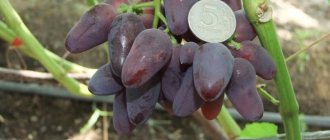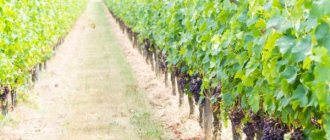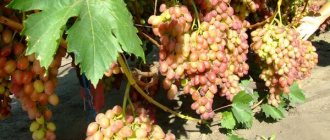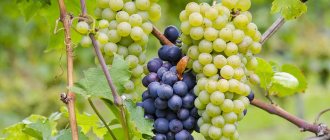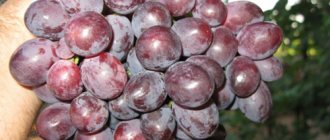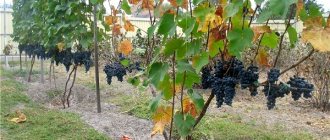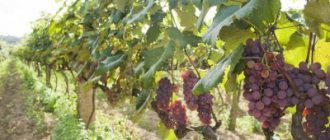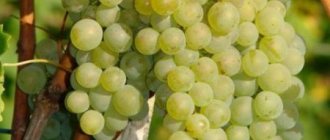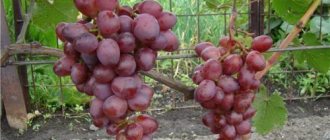Fruits and berries » Grapes
0
900
Article rating
Kira Stoletova
Grapes from America appeared in the 18th century. It has hybrids of different selections that are suitable for growing in different climatic conditions. The culture is resistant to frost and disease. America grapes are used for fresh consumption and in the preparation of drinks.
American grape varieties
New seedless grape varieties bred in the USA
NEW SEEDLESS VARIETIES FROM US BREEDING
FOR FRESH CONSUMPTION
Krasokhina S.I., VNIIViV im.
ME AND. Potapenko, Ph.D. agricultural n. Ganich V.A., VNIIViV im. ME AND. Potapenko, graduate student 346421, Baklanovsky Ave., 166, VNIIViV im. ME AND. Potapenko, Novocherkassk, Rostov region, Russia Among several thousand grape varieties currently known throughout the globe, seedless varieties form a special group. It is small in number, with about 70 varieties, of which Korinka (white and black) and Sultanina are of primary importance. About 80% of the vineyard area in the world is occupied by one seedless variety - White Kishmish oval (synonyms: Sultanina, Thompson Sidlis, Ak Kishmish, Bedona, Kishmish Safet, Indian Kishmish, Yellow Kishmish, etc.).
The bulk of the known seedless varieties belong to the species Vitis vinifera L., which is characterized by low resistance to frost and instability to fungal diseases, demands on the amount of active temperatures, and a low fruiting coefficient in the conditions of the Lower Don region.
In recent decades, interest in seedless grapes has increased in the world, and it is the consumer demand for seedless grapes for fresh consumption, in addition to dried products, that is increasing. This fact increases the relevance of grape breeding work. In the intraspecific (Vitis vinifera L.) world selection of seedless varieties, a fairly large number of varieties have been created, including large-berry ones. But these varieties are practically unsuitable for cultivation in the northern regions of Russia, as they suffer from harsh climatic conditions, lack of heat, have low yields and are severely damaged by fungal diseases.
The most reliable and less dangerous (from an environmental point of view) way to obtain high yields in unfavorable growing conditions is to introduce new grape varieties into the assortment that would be distinguished by high genetic resistance to biotic and abiotic environmental factors, potential productivity and harvest quality.
Economic calculations show that a rationally developed and zoned assortment of grapes for a certain economic zone should consist of a small number of the highest-yielding, disease-resistant, high-quality varieties for different purposes and different ripening periods. Each zoned grape variety of any direction of use must be economically profitable on the farm. It is well known that there are no universal grape varieties in nature. According to I.V. Michurin, even the best variety cultivated in specific conditions has certain disadvantages, therefore the zoned assortment must be continuously improved and updated.
One of the fastest and most effective methods for improving assortment is introduction. To ensure the full realization of the genotypic productivity potential of new varieties, it is necessary to study their behavior in specific growing areas.
We believe that the greatest interest in solving the problem of improving the assortment of grape plantings for the northern zone of industrial viticulture of the Russian Federation is represented by varieties obtained with the participation of the species Vitis labrusca L. In particular, interspecific seedless hybrids created in the USA based on the species Vitis labrusca L., and introduced into the Russian Federation, having an early ripening period, high resistance to frost, oidium and mildew, good harvest quality and suitable for fresh consumption.
Continuing the topic of the prospects for cultivating varieties obtained with the participation of the species Vitis labrusca L. (see “Winemaking and Viticulture, No. 5, 2005), within the framework of the dissertation work “Grapes of the species Vitis labrusca L. as a source material for improving the assortment of grape plantings in Don" On September 15, 2005, we conducted another survey of consumer taste preferences for seedless grape varieties (closed tasting). Since seedless varieties are very popular among children, two groups of people were involved in the survey:
The first group is students of the Don State Agrarian University, majoring in “Agronomy” and “Horticulture and Viticulture”, average age 20 years, number of respondents - 77 people.
The second group - children of primary school age, average age 11 years, number of respondents - 24 people.
The berries of six grape samples were presented for tasting: the zoned variety Korinka Russian (Zarya Severa x Kishmish Black) selection of VNIIGiSPR named after. I.V. Michurina; variety Pink Beads (obtained from open pollination of the Madeleine Angevin variety) selection of the Kazakh NIIPiV; variety Dream (Chaush pink x Kishmish black) selection of Odessa Agricultural Institute, Ukraine; and the studied varieties with labrusca aroma Venus (Alden x NY 46000), Reliance pink seeds (Ontario x Suffolk pink) and Einsett seeds (Fredonia x Canner) selection of the USA. All presented varieties had berries of approximately the same size and weight, with the exception of the Russian Korinka variety. Economically valuable and some chemical and technological indicators of the studied varieties are presented in the table.
Related article: Grape variety Couderc 4401
History of the variety: from Italy to the Balkans
“The history of zinfandel is like a thriller, a mystery that was only recently solved,” wrote wine critic Jancis Robinson. The intricate origins and geography of movements of the variety that the Americans considered theirs are truly worthy of a separate story.
Schwarzenegger vs.
In 2006, then-California Governor Arnold Schwarzenegger introduced a bill to designate Zinfandel as the state's official historic wine. Schwarzenegger did not support the idea: “It is wrong if California is known in the world only by one variety.” Producers also agreed, preferring other varieties - cabernet sauvignon and chardonnay. In addition, the Californian origin of zinfandel was disputed by Italians and Croatians. And they had every right to do so.
From American East to West
Zinfandel has been popular in California since the Gold Rush. Until the 90s, the roots of the variety were unknown.
“Nobody knew the pedigree of Zinfandel. We could trace the origins of other varieties, such as cabernet sauvignon or chardonnay, but not zinfandel. California was the only place where zin was grown,” explained expert and state wine judge Rod Byers.
Moreover, back in the 70s, wine historian Charles Sullivan found out that the variety arrived in California from the east of the country. In the 1820s, George Gibbs, a vineyard owner on Long Island, New York, imported and planted 28 varieties purchased from Austria. Among them was zinfandel. Soon this grape (in the archives of 1832 it was mentioned under the name zinfardel) began to be grown in greenhouses in Boston, and in the mid-19th century its cuttings came to California. The state's climate was optimal for the variety, which quickly spread throughout the vineyards.
Italy and Primitivo
All these intra-American migrations of Zinfandel did not explain the roots of the variety. But in 1967, oenologist Austin Goin, while in Puglia (southern Italy), tasted Primitivo wine and found it similar to zinfandel. Upon returning home to the States, he took up this issue closely and drew conclusions about the identity of the varieties.
DNA research conducted in the 1990s by Carol Meredith, a colleague of Goin's at the University of California, confirmed that zinfandel is similar to the Italian primitivo. But while this study put an end to the debate about the connection between the two varieties, it opened an even older chapter in the history of zinfandel.
Croatian roots
“Italian researchers told me that Primitivo was not born in Italy,” Carol Meredith said. Indeed, one of the documents mentioned that the Catholic monks of Dalmatia (part of the Balkan Peninsula, the territory of modern Montenegro and Croatia), who fled from religious persecution to Italy in the 18th century, brought primitive vines with them.
The focus of research has shifted to Croatia. The main suspect in the history of Zinfandel was initially the famous local variety Plavac Mali. Meredith spent several years studying the variety, but while Plavac Mali was close, it was not identical to Zinfandel.
The mystery was solved with the help of Croatian colleagues, with whom Carol Meredith identified a direct relative of the zine. This is an almost extinct variety of crljenak kastelanski (its other name is tribidrag), which lives in the Split region on the Dalmatian coast.
At the same time, it became clear how Zinfandel and Plavac Mali are related. The latter, which arose as a result of crossing the Crlenak Kastjelansky and the Dobrichic variety, was not the parent, but the half-brother of the Zina.
Phylloxera ravaged the region at the end of the 19th century, and instead of replanting Crlenak, the Croats replaced it with Plavac. Fortunately, before Crlenak disappeared, its cuttings found their way to the Imperial Nursery in Vienna, from where they were transported to the States.
The controversy is not over
The circle seems to have closed. Crlenak Kastella, Zinfandel and Primitivo all share the same DNA. It was Crlenak who jumped over the Adriatic to become primitive in Italy. And it was Zrlenak, with a stop in Vienna, that found its way to George Gibbs' nursery on Long Island, eventually becoming Zinfandel, the pride of American winemakers.
However, several years ago, Montenegro also claimed its rights to zinfandel: local experts reported a connection between zin and the local variety kratosia.
It seems that the debate about the origin has not yet been settled.
“Carol Meredith, who traded her university job for her own Zinfandel vineyard in the Napa Valley in the mid-2000s, believes we will never know exactly where the variety came from,” Jancis Robinson wrote in a Financial Times article. The Mystery of the Zinfandel Grape. And she summed it up: “Does it even matter where he comes from? Yes, but only for marketers."
American grapes: characteristics of varieties
American grapes are completely unpretentious in care. And at the same time it can produce incredible yields. In addition, these varieties are very frost-resistant. And also there is no need to additionally prepare them for winter, in particular, to cover them.
Many gardeners dream of not having to spend too much time and energy growing grapes. And also get a bountiful and very tasty harvest. To do this, you need to find a suitable variety from the whole variety. And this dream will definitely come true.
American Seneca grape
The first variety from the American selection that we will talk about is a variety called Seneca. It is one of the most popular and, perhaps, the best varieties. Does not require shelter for the winter, produces a high level of abundant harvest. This requires an arched formation of the plant.
The bunches have an average size and the same average density. The berries are not too large, round. They have a pleasant greenish-golden hue. The taste of the berries is very pleasant and harmonious. Great for making various jams, preserves and, of course, drinks.
At the same time, the variety is quite frost-resistant. As a rule, it is not affected by mildew. And to preserve the harvest, it is enough to spray the plant twice a season for preventive purposes.
Variety Bluebell
Bluebell is one of the oldest varieties in the entire American selection. It has a universal purpose. The berries can be eaten fresh. And also prepare various jams, desserts, preserves or other preparations from them. The berries are round. They have a distinct Isabella taste.
The harvest ripens by early autumn. The difference between the variety is also that it is extremely winter-hardy. Without additional protection and shelter, the bushes can withstand frosts down to -35 degrees. And this was proven by gardeners who were already growing these grapes in their garden plots.
Another advantage of the Bluebell variety is that it is very resistant to fungal diseases. And this is also one of the signs by which gardeners often choose it.
Planting and care
Planting material is harvested in the spring. For planting, shoots with up to 7 eyes are used. The diameter of the vine is up to 1.1 cm, the length is up to 40 cm. The healthier the seedling, the better the harvest.
At the first pruning in the spring, up to 8 buds are left. Within 2 months after planting, they engage in systematic loosening and watering. For American selections, the most dangerous disease is oidium - it is imperative to carry out prevention against it.
If the climate is arid, mulching is done. During flowering, a small number of flowers are picked off: this increases the size of the bunch by 80%. The bushes are constantly inspected to be able to detect diseases or pests in time.
Variety Vulture
Vulture is an American variety that ripens quite early. The weight of one bunch can vary from 300 to 400 grams. The berries are usually a rich dark purple hue. When fully ripe they take on a deep black hue.
The aroma is slightly isable, as is the case with many American grape varieties. The weight of one berry varies from 3.5 to 4.5 grams. Two treatments per season are sufficient. This will help protect the plant from bacteria and pests for preventive purposes. Ripening occurs around the end of August. And berries, as a rule, have a universal purpose.
American Buffalo Grape
This variety can grow very large. And at the same time it is characterized by high productivity. If the gardener follows all the rules of agricultural technology and subsequent care, then the bunch can reach a weight of half a kilogram. The berries have a black tint. They are medium in size, very aromatic and tasty.
If you carry out arched shaping, then you can remove up to 100 kilograms of high-quality berries from one bush per season. In addition, the berries are well stored and tolerate long-distance transportation. The fruits ripen at the beginning of autumn, in September. But the variety also has a drawback - the cuttings are very capricious. They may not take root at all, so you should constantly monitor them.
Description of culture
The varieties brought to America from Europe did not take root. They died out due to infections and fungus. To develop a sustainable and healthy vineyard, species from Europe and America were combined.
America grapes are grown in Russia without any difficulties: they are resistant to diseases and low temperatures. This culture can withstand -34°C.
The most comfortable conditions in the Russian Federation for the following American grape varieties:
Variety Riparia
The culture is medium in size, its leaves are large and pointed. The bunch is small, the fruits are black, the flower is bisexual.
Riparia takes root either in clay soils or sandy ones. The crop needs a lot of fertilizers. The presence of lime in the ground will lead to the death of the entire bush. The hybrid is resistant to various types of diseases. Riparia is early ripening - ripening occurs in a period of up to 180 days under favorable climatic conditions.
Variety Rupetris
The plant needs good lighting
Features of the Rupetris variety:
- grown in the American South and Center;
- the growing area should be well lit;
- shoots spread in a creeping manner;
- the vines darken after a year of growth;
- the foliage is small.
The berry tastes grassy. The soil is suitable clay and rocky.
The variety survives well in hot, dry climates. This selection result is resistant to cold weather: it can withstand down to -28°C.
Berladieri variety
Hybrids of the species are grown in the south, north and center of America. The vines are climbing. The height of the bush is average. The color of a one-year-old vine is brown. The foliage is small. The clusters can be of different sizes, the berries are large and blue.
Unlike other American varieties, Berladieri thrives in soil containing a high percentage of lime. It is resistant to phylloxera. It is difficult for new seedlings to take root.
Varieties Labrusca and Monticola
These varieties are similar to Rupetris. The difference is the liana-like type of shoot. The survival rate of planting material is poor. In Russia, both types are used for vaccination.
The size of the vine is up to 27 cm. The color of the shoot is brown. The clusters are small, the fruits are black and round. The taste is reminiscent of strawberries.
These varieties are resistant to any climatic conditions.
Ontario variety
Ontario - this bush has an average growth, while very large leaves are formed on it, which are lowered to the edges. This makes the bush seem a little wilted, but this is only one of the features of the variety, so there is no reason to worry.
The clusters are of medium size, the berries themselves are round, and in terms of taste, the variety is almost one of the best of all the uncovered American grape varieties that have been bred to date. The variety is very resistant to frost and generally tolerates too dry weather. Does not require protection against mildew, which is very common among vineyards today.
Thus, today a sufficient number of American grape varieties have been bred that perfectly adapt to the conditions. And they can withstand even the most severe frosts. Of course, it is necessary to follow all agrotechnical rules and carry out some preventive procedures in order to get the maximum result not only in a healthy bush, but also in ensuring that it bears fruit regularly and abundantly.
How to plant a vineyard with America variety plants
Hybrid America is planted in the same way as other varieties of grape plants. Grape cuttings are usually harvested in spring.
Gardeners usually select branches that have a brown color, which indicates their ripening. Depending on the number of internodes, the cuttings must be cut to a certain size. Typically, the optimal number of internodes varies between 4-7, while the optimal thickness of the workpiece should be from 0.8 to 11 mm, and the length within 20-40 cm. You need to choose plants with bark that is not mechanically damaged. Planting material should be straight and healthy. It is necessary to process plant materials after cutting, which helps protect against diseases and can also protect the harvest from destruction.

